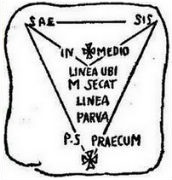Coume Sourde “Stone”
Questions & Answers
Paul Smith
25 August 2015

1967 Version
1) - Who first mentioned the existence of the Coume Sourde “Stone” ?
Noël Corbu first mentioned the alleged existence of the Coume Sourde “Stone” on a Frances-Inter Radio Programme that was broadcast on 30 July 1962. Corbu claimed it was discovered in 1928 by Ernest Cros.
2) - Did Ernest Cros ever mention the Coume Sourde “Stone” ?
No
3) - If the Coume Sourde “Stone ” was discovered in 1928 news of its discovery from that year must be checked. What are the details?
There are no details dating from the year of its alleged discovery. Its alleged existence was mentioned for the first time by Noël Corbu on the 1962 Frances-Inter Radio Programme.
4) - Had Ernest Cros discovered the Coume Sourde “ Stone” in 1928 that information would have been passed on creating secondary sources. Are there any secondary sources dating from between 1928-1962?
Not even secondary sources.
5) - So the Coume Sourde “Stone” was never mentioned even once by anyone between 1928-1962. A period of 34 years. An incredible silence for an alleged archaeological “artefact”
Correct.
6) - How many examples are there of archaeological artefacts that have been discovered without being mentioned once in 34 years since initial discovery?
Good question
7) - Have any archaeological organisations shown any interest in the Coume Sourde “Stone” – are there any articles about it in archaeological journals, etc?
No, it is regarded as another example of the marvels and mysteries of Rennes-le-Château that does not belong to the world of serious archaeological research.
8) - Could the Coume Sourde “Stone” therefore be a forgery?
Of course. The story of the Coume Sourde “Stone” is also part of the story of the REDDIS REGIS gravestone, also first mentioned by Noël Corbu in 1962 also unattested to before 1962. Noël Corbu claimed both “artefacts” were linked with the tombstone of Marie de Negri d'Ables, Countess Hautpoul-Blanchefort.
9) - Did Noël Corbu ever provide information of the drawing of the tombstone of Marie de Negri d'Ables that was published in an article by Elie Tisseyre in 1906 in the Bulletin of the Society for Scientific Study of the Aude? Corbu was a member of that Society.
No, Corbu did not do that. There can only be one explanation for it – Corbu suppressed the information about the drawing of the tombstone found in Elie Tisseyre's 1906 article in order to promote his allegations about the Coume Sourde “Stone” and the REDDIS REGIS tombstone.
10) - Are there any testimonies from past inhabitants of Rennes-le-Château who saw the Coume Sourde “Stone” or/and the REDDIS REGIS tombstone? Are there any photographs or drawings of these “artefacts” dating from between 1928-1962?
No, there are no testimonies from any past Rennes-le-Château inhabitants relating to either of the “artefacts” and there are no photographs or drawings in existence dating from between 1928-1962.
11) - What about the “Cros Report”? Can that be trusted?
Absolutely not. The “Cros Report” refers to events that happened after the death of Ernest Cros, therefore it cannot be by Cros: it must be regarded as spurious for that reason alone. The “Cros Report” was possibly inspired by Gérard de Sède's 1967 book L'Or de Rennes because it contains a legendary quotation attributed to Bérenger Saunière found in that book.
12) - If Noël Corbu faked the stories about the Coume Sourde “Stone” and the REDDIS REGIS gravestone, can he be trusted about anything else?
It looks like Noël Corbu got his ideas about the the Coume Sourde “Stone” and the REDDIS REGIS tombstone from the drawing of the Marie de Negri d'Ables gravestone found in the 1906 Elie Tisseyre article – just like he got the idea to attribute everything to Ernest Cros from the 1959 article about the Knights Templar by Abbé Mazières because it mentioned his name.
Noël Corbu had previously promoted fake claims and stories about Blanche of Castille and the shepherd Ignace Paris during the mid-1950s. It was also during this period that Noël Corbu triggered the legendary stories about Bérenger Saunière discovering parchments in the hollow pillar of his church.
Corbu attributed these words to Marie Dénarnaud for the first time in 1962: “My little friend, one day I’ll leave you so much money you won’t know how to spend it!”
These fake claims by Noël Corbu about Bérenger Saunière and Rennes-le-Château were subsequently used by Pierre Plantard and Philippe de Chérisey as the basis for their fake histories of the Priory of Sion during the 1960s.

The Coume Sourde “Stone” was modelled on the Catholic symbol The Shield of Trinity

|





